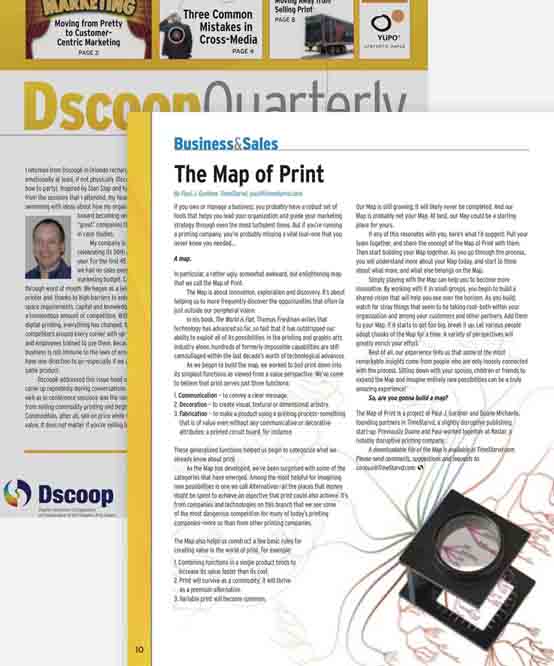|
If you own or manage a business, you probably have a robust set of tools that helps you lead your organization and guide your marketing strategy through even the most turbulent times. But if you're running a printing company, you're probably missing a vital tool - one that you never knew you needed... A map. In particular, a rather ugly, somewhat awkward, but enlightening map that we call the Map of Print. The Map is about innovation, exploration and discovery. It's about helping us to more frequently discover the opportunities that often lie just outside our peripheral vision. In his book, The World is Flat, Thomas Friedman writes that technology has advanced so far, so fast that it has outstripped our ability to exploit all of its possibilities. In the printing and graphic arts industry alone, hundreds of formerly impossible capabilities are still camouflaged within the last decade's worth of technological advances. As we began to build the map, we worked to boil print down into its simplest functions as viewed from a value perspective. We've come to believe that print serves just three functions:
These generalized functions helped us begin to categorize what we already know about print. As the Map has developed, we've been surprised with some of the categories that have emerged. Among the most helpful for imagining new possibilities is one we call Alternatives - all the places that money might be spent to achieve an objective that print could also achieve. It's from companies and technologies on this branch that we see some of the most dangerous competition for many of today's printing companies - more so than from other printing companies. The Map also helps us construct a few basic rules for creating value in the world of print. For example:
|
Our Map is still growing; it will likely never be completed. And our Map is probably not your Map. At best, our Map could be a starting place for yours. If any of this resonates with you, here's what I'd suggest: Pull your team together, and share the concept of the Map of Print with them. Then start building your Map together. As you go through the process, you will understand more about your Map today, and start to think about what more, and what else belongs on the Map. Simply playing with the Map can help you to become more innovative. By working with it in small groups, you begin to build a shared vision that will help you see over the horizon. As you build, watch for stray things that seem to be taking root - both within your organization and among your customers and other partners. Add them to your Map. If it starts to get too big, break it up. Let various people adopt chunks of the Map for a time. A variety of perspectives will greatly enrich your effort. Best of all, our experience tells us that some of the most remarkable insights come from people who are only loosely connected with the process. Sitting down with your spouse, children or friends to expand the Map and imagine entirely new possibilities can be a truly amazing experience! So, are you gonna build a map?
The Map of Print is a project of Paul J. Gardner and Duane Michaelis, founding partners in TimeStarvd, a slightly disruptive publishing start-up. Previously Duane and Paul worked together at Rastar, a notably disruptive printing company. A downloadable file of the Map is available at TimeStarvd.com. Please send comments, suggestions and requests to: curious@timestarvd.com Reprinted courtesy Dscoop (Digital Solutions Cooperative) - a cooperative of HP Graphics Arts users, © 2011. |
|
Concept by Paul J Gardner and Duane Michaelis • Map of Print (tm) © 2011 TimeStarvd, LLC is licensed for free, non commercial use under a Creative Commons "Attribution, Non-Commercial, Share Alike" License |
|

